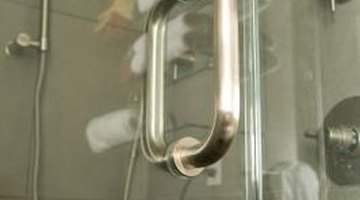How to Repair Nail Holes in Bath Walls From a Shower Door Removal
Shower doors pivot or slide on an aluminum frame that attaches to the shower walls by plastic anchors or cement fasteners. After removing the frame, unsightly holes may remain in the shower walls. The method to repair the holes depends on the type of shower walls. You can repair shower walls covered in ceramic tile or natural stone with a color-matched grout. For shower walls covered in vinyl or fiberglass panels, a color-matched caulk is recommended.

Step 01
Remove any plastic anchors that remain in the holes. An easy way to do this is by threading a screw into the anchor a couple of turns then pulling it out with a pair of pliers. If screwed in too far, the anchor will expand, making it difficult or impossible to remove.
Step 11
Scrape away any debris or leftover caulking from the shower walls with a putty knife. Dampen a rag with acetone and clean the area thoroughly. Be careful not to scratch the shower wall surface when using the putty knife.
Step 21
Use a grout color chart to determine a grout or caulking color similar to that in the shower walls. Since these holes are usually small, a non-sanded grout offers the best results.
Step 31
Mix a small amount of grout in a bucket with a margin trowel to repair holes on ceramic tile or stone shower walls. The grout consistency should be similar to peanut butter.
Step 41
Fill the nail holes with grout applied with a grout float or the putty knife. Gently wipe away any excess with a damp sponge. For vinyl or fiberglass walls, fill the holes with color-matched tub and tile caulk or silicone. Smooth the caulk into the holes with your finger and wipe away the excess with a damp rag. If using silicone, dampen a rag with acetone to remove any excess.
References
Tips
- You can also insert stainless steel screws into the holes instead of patching them.
- Hire a professional tile installer to replace any damaged tiles.
Warnings
- Use acetone in a well-ventilated area. To avoid damage to vinyl or fiberglass, test the acetone in a small, inconspicuous area.
Writer Bio
Robert Ferguson has been a writer since 2000. His published work includes material for major companies in the home improvement, plumbing, HVAC and power tool industry. Ferguson is a self-employed, licensed building contractor in Florida with more than 30 years of hands on experience experience focusing primarily on residential remodeling, repair, renovation and construction.
Photo Credits
- Jupiterimages/Photos.com/Getty Images
More Articles



